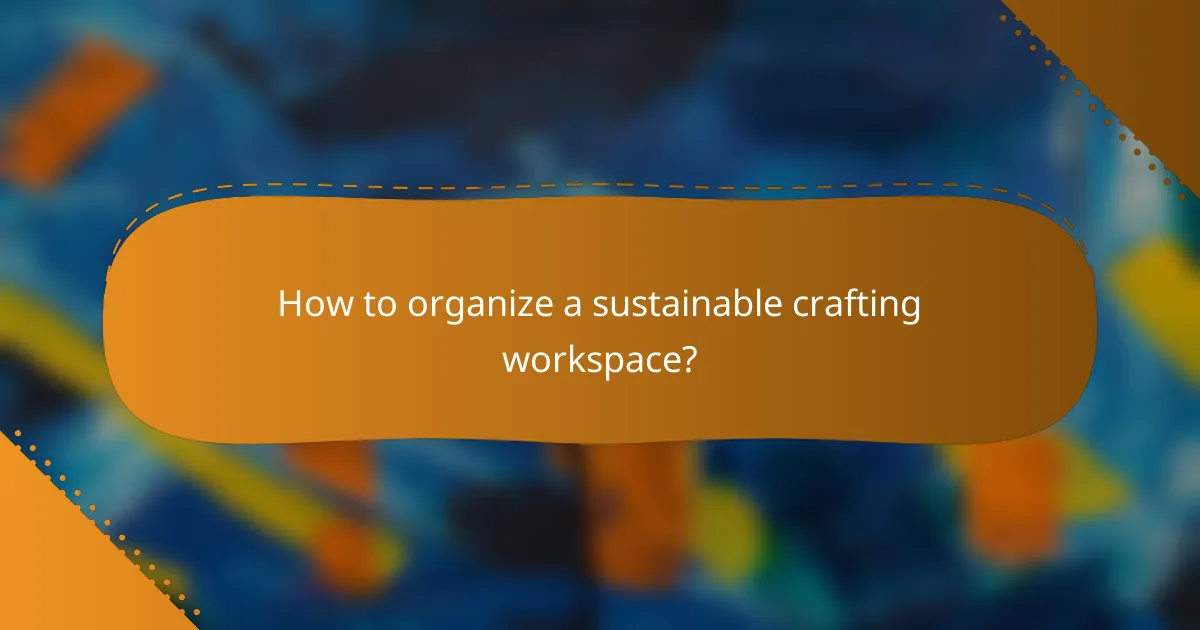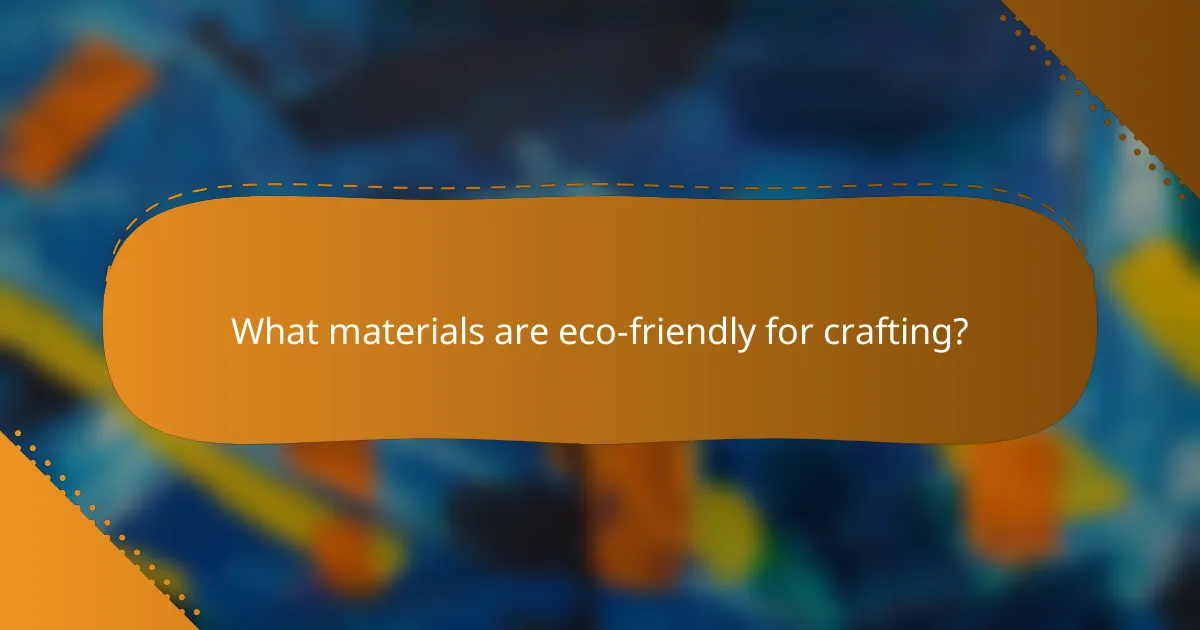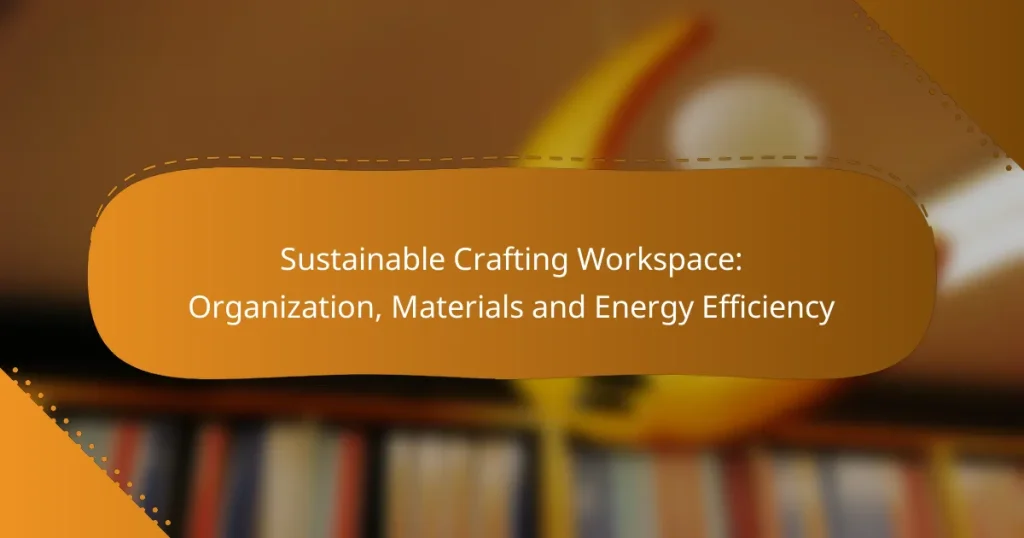Creating a sustainable crafting workspace involves prioritizing efficient organization, eco-friendly materials, and energy-saving practices. By structuring your area thoughtfully, you can enhance productivity while reducing waste and environmental impact. Utilizing materials that are recycled or biodegradable further promotes sustainability, while optimizing energy use can lead to significant savings and a greener workspace.

How to organize a sustainable crafting workspace?
To create a sustainable crafting workspace, focus on efficient organization, eco-friendly materials, and energy-saving practices. A well-structured area enhances productivity while minimizing waste and environmental impact.
Use modular storage solutions
Modular storage solutions allow for flexibility and adaptability in your crafting space. Consider using stackable bins or adjustable shelving that can be rearranged as your needs change. This approach not only maximizes space but also reduces the need for new furniture, promoting sustainability.
Look for storage options made from recycled materials or sustainable wood. This choice not only supports eco-friendly practices but can also add a unique aesthetic to your workspace.
Implement a labeling system
A clear labeling system is essential for maintaining organization in your crafting area. Use eco-friendly labels made from recycled paper or biodegradable materials to identify storage bins and shelves. This helps you quickly locate supplies and reduces the time spent searching for items.
Consider color-coding labels based on categories, such as materials, tools, or projects. This visual cue can enhance efficiency and make it easier to maintain order in your workspace.
Maximize vertical space
Maximizing vertical space is crucial in smaller crafting areas. Install wall-mounted shelves or pegboards to store tools and materials off the ground, freeing up valuable workspace. This not only keeps your area tidy but also makes items more accessible.
Use hooks or magnetic strips for hanging tools, which can help keep surfaces clear and organized. This approach encourages a more efficient workflow and reduces clutter.
Incorporate multi-functional furniture
Multi-functional furniture is a smart investment for a sustainable crafting workspace. Look for tables that can double as storage units or chairs that offer built-in compartments. This type of furniture maximizes utility while minimizing the need for additional pieces.
When selecting furniture, prioritize items made from sustainable materials. This ensures that your workspace remains eco-friendly while providing the functionality you need for crafting projects.

What materials are eco-friendly for crafting?
Eco-friendly crafting materials are those that minimize environmental impact and promote sustainability. They include items that are recycled, biodegradable, or made from natural resources, ensuring a lower carbon footprint and reduced waste.
Recycled paper products
Recycled paper products are made from post-consumer waste, reducing the need for virgin materials and conserving resources. Options include recycled cardstock, paper, and even specialty papers like handmade varieties. Look for products with a high percentage of recycled content to maximize sustainability.
When choosing recycled paper, consider its weight and texture based on your project needs. For instance, lighter papers are ideal for origami, while heavier cardstock works well for card making. Always check for certifications like the Forest Stewardship Council (FSC) label to ensure responsible sourcing.
Biodegradable glues and adhesives
Biodegradable glues and adhesives break down naturally over time, reducing landfill waste. These products are often made from plant-based materials and are free from harmful chemicals. Common types include starch-based glues and natural rubber adhesives.
When selecting biodegradable adhesives, ensure they are suitable for your specific crafting needs. For example, some may work well for paper projects but not for heavier materials. Always follow the manufacturer’s instructions for application and drying times to achieve the best results.
Natural fibers for textiles
Natural fibers such as cotton, linen, wool, and hemp are excellent choices for eco-friendly textile crafting. These materials are renewable and biodegradable, making them a sustainable alternative to synthetic fabrics. They also often have a lower environmental impact during production.
When working with natural fibers, consider their properties, such as breathability and durability. For instance, cotton is soft and versatile, while hemp is strong and resistant to mold. Look for organic certifications to ensure the fibers are grown without harmful pesticides or chemicals.
Non-toxic paints and finishes
Non-toxic paints and finishes are essential for safe crafting, especially in projects involving children. These products are formulated without harmful solvents and heavy metals, making them safer for both users and the environment. Water-based paints are a common choice for eco-friendly crafting.
When selecting non-toxic options, check for certifications such as ASTM D-4236 or AP (Approved Product) labels, which indicate safety standards. Keep in mind that while non-toxic paints are safer, proper ventilation is still important during application to minimize inhalation of any fumes.

How to improve energy efficiency in a crafting space?
Improving energy efficiency in a crafting space involves optimizing lighting, appliances, and energy sources to reduce consumption and costs. Implementing these strategies can lead to significant savings and a more sustainable workspace.
Use LED lighting
Switching to LED lighting is one of the simplest ways to enhance energy efficiency. LEDs consume up to 80% less energy than traditional incandescent bulbs and have a longer lifespan, often lasting over 25,000 hours.
When selecting LED lights, consider the color temperature that best suits your crafting activities. Warmer tones (around 2700K) are ideal for cozy environments, while cooler tones (5000K and above) can enhance visibility for detailed work.
Install energy-efficient appliances
Investing in energy-efficient appliances can significantly reduce energy consumption in your crafting space. Look for appliances with the ENERGY STAR label, which indicates they meet strict efficiency guidelines set by the U.S. Environmental Protection Agency.
Consider using compact appliances, such as small refrigerators or microwaves, that are designed for lower energy use. Regular maintenance, like cleaning filters and coils, can also help these appliances operate more efficiently.
Utilize natural light
Maximizing natural light can greatly reduce the need for artificial lighting during the day. Position your crafting workspace near windows or skylights to take advantage of sunlight, which can enhance your mood and creativity.
To control glare and heat, consider using sheer curtains or blinds that allow light in while providing some shade. This approach not only saves energy but also creates a pleasant working environment.
Incorporate solar panels
Installing solar panels can provide a renewable energy source for your crafting space, significantly lowering electricity bills. Depending on your location, solar panel systems can cover a substantial portion of your energy needs, especially in sunny regions.
Before installation, assess your roof’s suitability for solar panels and check local regulations or incentives that may be available. Many areas offer tax credits or rebates that can offset initial costs, making solar energy a more accessible option.

What are the benefits of a sustainable crafting workspace?
A sustainable crafting workspace offers numerous advantages, including a reduced environmental footprint, cost savings, and improved creativity. By focusing on eco-friendly practices, crafters can create a more efficient and inspiring environment.
Reduced environmental impact
A sustainable crafting workspace minimizes waste and conserves resources, contributing to a healthier planet. This can be achieved by using recycled materials, opting for non-toxic supplies, and implementing energy-efficient practices.
For instance, choosing biodegradable adhesives and paints can significantly lower harmful emissions. Additionally, setting up a recycling system for scraps and unused materials helps divert waste from landfills.
Cost savings on materials
Implementing sustainable practices can lead to substantial savings on crafting materials. By sourcing local and recycled supplies, crafters can often find lower-cost alternatives while supporting their community.
Consider bulk purchasing or sharing resources with fellow crafters to reduce expenses. Utilizing leftover materials from previous projects can also stretch your budget further, allowing for more creative freedom without overspending.
Enhanced creativity and productivity
A sustainable crafting workspace fosters a more inspiring atmosphere, which can boost creativity and productivity. Natural lighting, organized spaces, and eco-friendly materials can enhance focus and motivation.
Incorporating plants into your workspace not only improves air quality but also creates a calming environment. Additionally, a well-organized area minimizes distractions, allowing for a more efficient crafting process.

What criteria to consider when selecting sustainable crafting materials?
When selecting sustainable crafting materials, prioritize eco-friendliness, local sourcing, and certifications that ensure minimal environmental impact. Consider the lifecycle of the materials, including their production, use, and disposal, to make informed choices that align with sustainability goals.
Source from local suppliers
Sourcing materials from local suppliers reduces transportation emissions and supports the local economy. Look for craft stores or artisans within a reasonable distance to minimize your carbon footprint. This practice not only fosters community relationships but often results in fresher, higher-quality materials.
Additionally, local suppliers may offer unique, region-specific materials that can enhance your crafting projects. Consider visiting farmers’ markets or craft fairs where local artisans showcase their goods, allowing you to discover sustainable options firsthand.
Check for certifications
Certifications provide assurance that materials meet specific environmental and social standards. Look for labels such as FSC (Forest Stewardship Council) for wood products, GOTS (Global Organic Textile Standard) for textiles, or recycled content certifications. These indicators help verify that your materials are sustainably sourced and produced.
Be aware that not all certifications are created equal. Research the standards behind each label to ensure they align with your sustainability values. A good practice is to create a checklist of preferred certifications to streamline your material selection process.


